
table of contents
- Plant romance: 9 tips
- The right color spectrum
- Plant in stages
- Create lawns in a targeted manner
- Roses over roses
- Enduring classics
- Annual highlights
- Integrate trees
- Don't forget potted plants
- Magnificent fragrant plants
- 8 romantic design tips
- frequently asked Questions
Romantic gardens invite you to dream, stroll and read a good book. The garden design according to these concepts is still easier than expected. You will find 16 tips for your retreat in this guide.
In a nutshell
- use many plants
- Roses are ideal
- Divide the garden
- create winding paths
- Note the romantic color spectrum
Plant romance: 9 tips
Romantic gardens are characterized by their playfulness and the characteristic feeling that invites you to relax. The right plants and the way in which they are integrated into the garden in order to develop their calming effect are particularly important. The following 9 tips go into more detail:
The right color spectrum
Romantic gardens make use of plants of specific colors to create a dramatic effect. The various shades of green foliage are used as a canvas, while the flowers of the ornamental plants create the painting. To make the garden romantic, pastel tones such as soft pink, attractive purple and dreamy blue are best. They can easily be combined with white flowers to create a romantic garden decoration with flowers. Warmer colors like yellow, orange and red should only be used as accents as they are too noticeable.
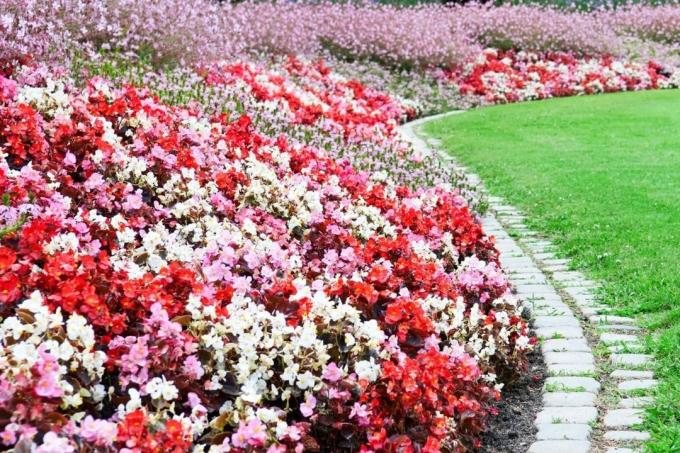
Plant in stages
One of the most characteristic elements of romantic gardens is the arrangement of the plants. Plants are planted as close together as possible to give off a feeling of lushness. You don't have to worry if the plants stick out over the paths. This "wild look" also contributes to the romantic garden design. It is important that you plant the types of plants in stages depending on their height. That is, the height of growth determines whether the plant is planted further in front or in the back. This classification enables interesting color games:
- low-growing: in the front area
- medium growth: in the middle area
- tall: in the rear area

Tip: There is nothing wrong with planting individual plants in a different row. That loosens up the system.
Create lawns in a targeted manner
In romantic concepts, lawns are used as a space between plants and not just as a place to lie or play. It is used to accentuate groups of plants to create a little more space. For example, lawns are ideal along with paths to better focus on the fullness of the plant beds. If you have a little more space available, you can even set up a small area especially for picnics between fragrant and ornamental plants.

Roses over roses
Roses (pink) are one of the most popular plants in romantic garden design. They seduce with their beauty and, thanks to their diversity of species and varieties, can be easily integrated into any concept. The best: You have a large selection of colors and growth forms available, which you can combine as you wish. If you want, you can primarily plant roses in the garden and combine them with perennials, herbs or small trees. Some varieties and types are particularly suitable:
- English roses like 'The Fairy'
- Historic roses like the Rose des Peintres
- Small shrub roses like 'Amica'
- Climbing roses like 'Bobby James'
- Rambler roses like 'Guirlande Rose'
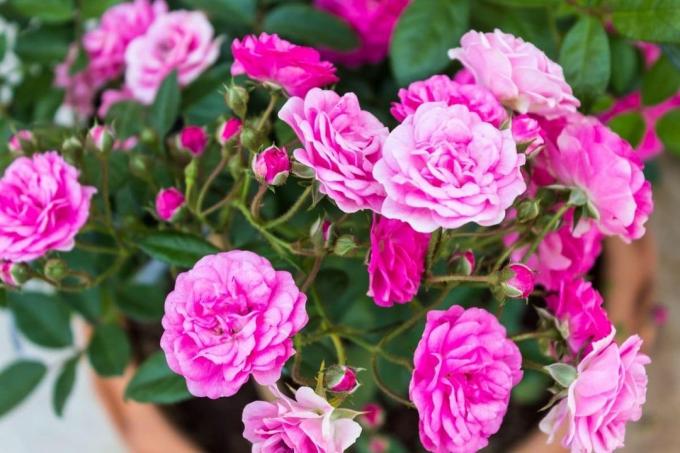
Note: Use climbing roses, rambler roses or other climbing plants, such as ivy (Hedera helix) to design the facade of the house facing the garden, walls, trellises or archways. A lush garden design can be achieved with climbing plants.
Enduring classics
Romantic gardens use a decorative mix of annual and perennial plants. The perennial plants can range from woody plants to perennial shrubs to grasses, which can then be planted as desired, for example:
- Deutzia (Deutzia)
- Noble thistles (Eryngium planum)
- Buttercup (Ranunculus)
- Hydrangeas
- Camellias (camelia)
- Peonies (Paeonia)
- Turkish Covenant Lines (Lilium martagon)
Many species found in cottage gardens are suitable for romantic concepts.
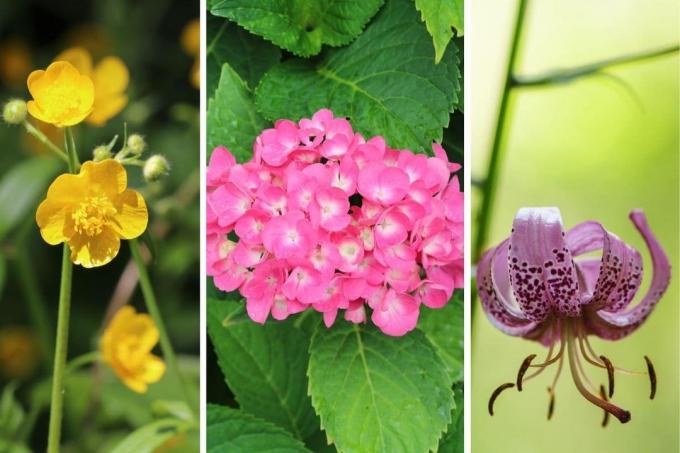
Annual highlights
With the annual plants, a special accent is set over the summer when the garden is in full bloom. They serve as an eye-catcher over the warm seasons and harmonize with the roses before they disappear from autumn and only appear again in the next year. Certain species that were already popular in the epoch of the same name are suitable for romantic gardens:
- Dahlias (Dahlia)
- Maiden in the Green (Nigella damascena)
- Cornflowers (Centaurea cyanus)
- Marigolds (Calendula officinialis)
- Bleeding heart (lamprocapnos spectabilis)
- Zinnias (Zinnia elegans)

Integrate trees
Trees should be used sparingly in romantic gardens if there is not enough space. Even a small fruit tree like a cherry or an apple tree is enough to catch the eye. Trees also offer a darker color palette and are therefore ideal as background plants. Trees are also popular as a basis for climbing plants, which reminds one of an old fairy tale forest after they have been planted.

Don't forget potted plants
In the garden, planters are often underestimated as a nuance. Use pots made of terracotta or clay that are placed on the terrace, along paths or on a fence. The tubs give the garden an even more personal touch, as accents can be set as desired. There are also numerous potted plants available, which can be easily integrated in terms of the color spectrum.

Magnificent fragrant plants
Of course, pleasantly fragrant plants should not be missing in the romantic garden. Ornamental plants form the basis of the gardens, but intensely fragrant plants are excellent for accentuating. They achieve the greatest effect in close proximity to seating such as a bench or a coffee table. Whole borders with fragrant plants, for example old roses or wild roses, can also be used. The following types are therefore ideal for an aromatic backdrop:
- Farmer's Jasmine (Philadelphus coronarius)
- Sweet pea (Lathyrus odoratus)
- Lilac (syringa)
- Herbs such as lavender (Lavandula), mint (Mentha) or rosemary (Salvia rosmarinus)
- Lilies (Lilium)
- Clematis
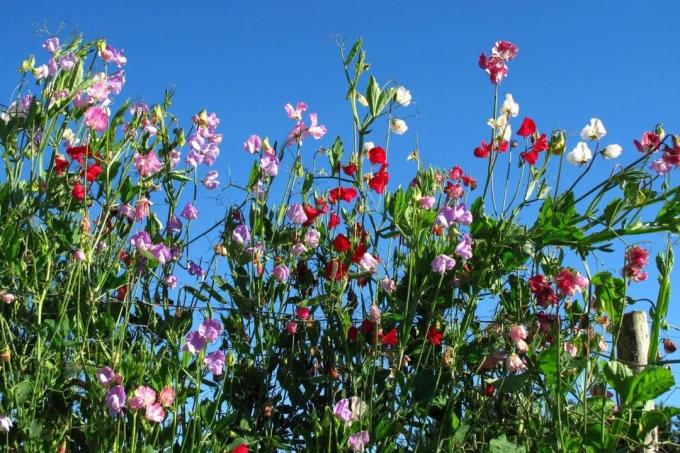
8 romantic design tips
The plants in romantic gardens must of course be coordinated with the rest of the garden design. There are therefore some concepts that are particularly suitable for dreamy green oases and that you can adopt. The following 8 tips go into more detail about garden design:
House design
A garden only works in harmony with the house and outbuildings such as garden sheds, pavilions and greenhouses. Historic old buildings with half-timbering, but also new buildings with great attention to detail such as wooden elements or pergola create the basis for the romantic garden. In this respect, it can make perfect sense to also select the dream property according to the desired design type of the garden. Regardless of whether it is an old or a new building: House prices can vary widely and a correspondingly spacious garden can quickly and significantly correct the value of a property upwards.
What makes a house romantic?
- Wooden windows with bars and shutters
- Wooden doors
- Arched window
- Dormers and filigree roof structures
- Wooden balconies
- Pergolas
- Truss
- Wooden terraces
- Brick and thatched roof (in Northern Germany)
Enclosures
Enclosures are one of the main elements of a romantic garden. They serve to delimit certain areas in order to design them individually and to surprise. For example, a waist-high brick wall that partially adjoins domestic climbing plants climbed up. At the same time, romantic gardens protect from prying eyes and exude a feeling of seclusion. One should lose oneself in them. For this reason, the following enclosures are particularly popular in romantic gardens:
- evergreen hedges
- Trellises with climbing plants
- Stone and brick walls
- Fences of wrought or cast iron or wood

Note: If you have a large garden, use low hedges or walls to divide the total area. The garden parts can then be set up without any problems.
Winding paths
Paths serve to connect the divided areas. They are laid out in such a way that the entire garden cannot be completely overlooked. Use winding paths, which then lead to clusters of pretty and fragrant plants, seating or decorative elements. In the sense of classic English gardens, the paths are not used to get from A to B quickly, but to exhaust every moment and linger when something new has been discovered. Excellent materials for the trails are:
- Stone paths
- Step plates
- gravel
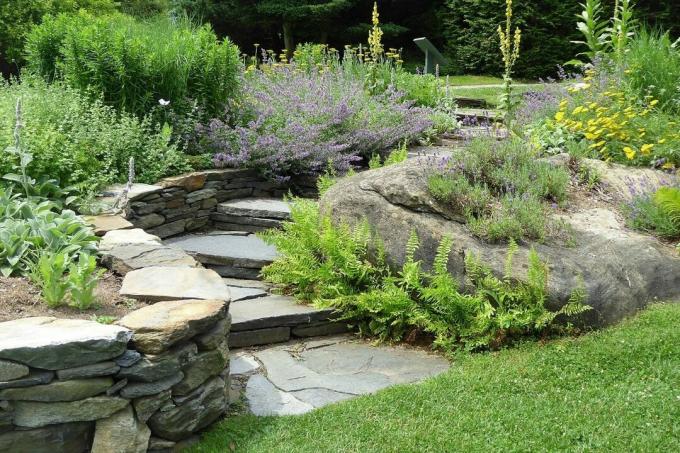
Tip: Let paths, as well as walls, be overgrown with moss. Mosses never look out of place in romantic gardens.
Design passages
Use arches, gates and openwork walls to create passages between each area. If you have a lot of space available, use open passages that reveal the next part of the garden decoration. In small gardens there is usually only space for a gate, which can then be integrated into the fencing of the property. Combine paths, stairs and passages in a playful style. The following passages stimulate the imagination:
- Opaque garden gates
- Rose arches
- Wall arches
- asian gate
- overhanging trees such as weeping willows (Salix babylonica)
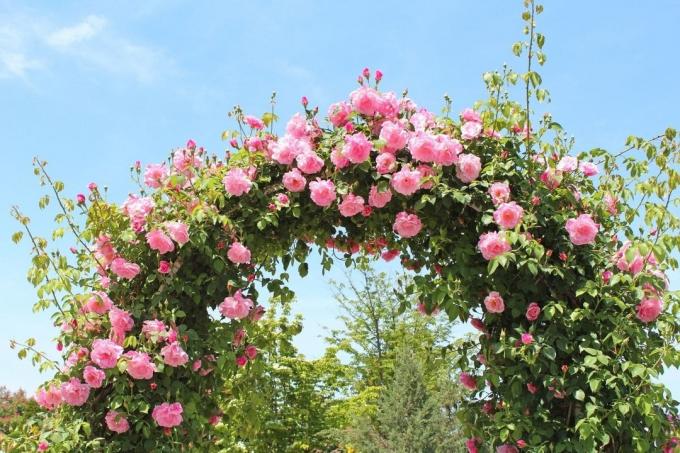
Water for relaxation
Water in every form is a must for romantic garden design. The gentle splashing of a small fountain is intended to relax or stimulate thought, while a quiet surface of the water acts like a mirror. All these elements can be added decoratively to the garden. Make use of the following elements:
- Fountain
- Streams
- Bowls of water
- Bird baths
- Garden ponds

Set up seating
Another aspect of the romantic garden design is seating. They provide relaxation and should therefore be set up so that the plants and decorations are in close proximity. This way you can enjoy the garden in all its glory. The following seating options are therefore ideal for romantic gardens:
- Coffee tables with chairs
- Garden benches
- Rocking chairs
- Seat stones
- Rock

Statues as eye-catchers
Statues are ideal to present playful or melancholy elements in the romantic garden. The statues are placed in such a way that they harmonize with the plants and can even be consumed by them. Romantic garden decoration relies on longing and can even depict the past, which is what makes overgrown statues so appealing. Of course, you can place the statues on walls, pedestals or the like. You can place the following decorations in the same way:
- Vases and amphorae
- Metal decorations such as old oil lamps
- Columns of different heights
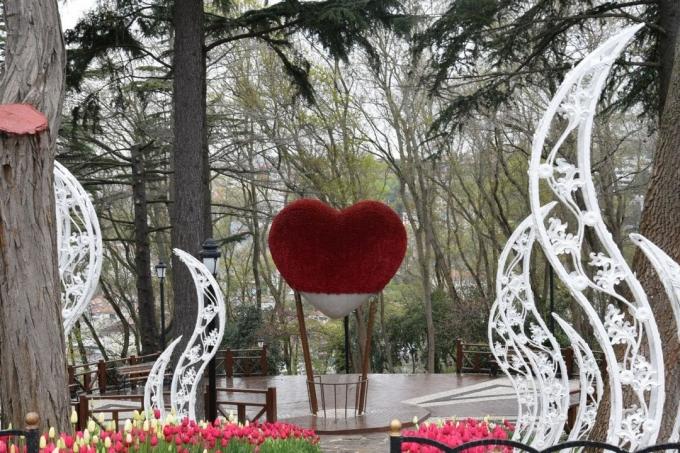
Use alternative planting options
What is meant by that? Use creative elements as planters to bring the playful character even more into focus. For example, you can convert an old wheelbarrow into a planter or use a metal bathtub for this purpose. You can therefore place these alternatives scattered between groups of plants, under a tree or simply next to a bird bath. Let your imagination run wild for this touch.
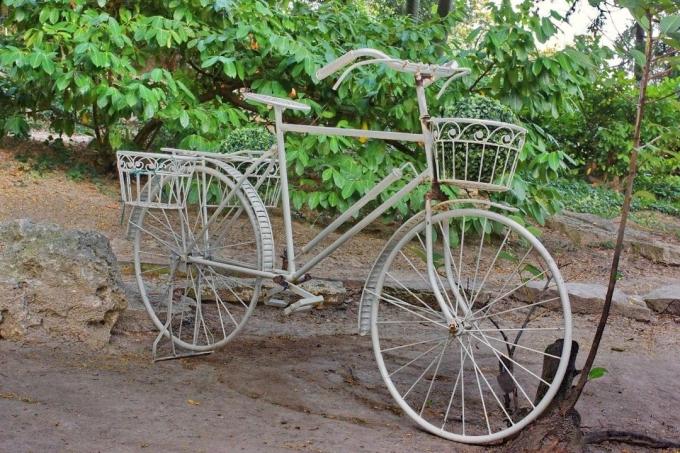
frequently asked Questions
Torches or lanterns that are placed along the paths, near seating or special corners are particularly popular for this garden concept. Also popular are fairy lights for outdoors, which can be hung in trees or arbors, for example.
Yes, kitchen gardens can also be created with the romantic garden concepts. Small kitchen gardens that exude a rustic charm and are separated by low fences or walls are particularly popular. Decorative items such as an old water pump also support the character.
Do without strong symmetry, as is used, for example, in baroque palace gardens. A romantic garden should be playful, not take itself too seriously and always come up with a surprise. Paths, beds and borders that are completely straight also appear a bit strict.
